Joseon
The Joseon dynasty (also transcribed as Chosŏn or Chosun, Korean: 大朝鮮國; 대조선국, lit. 'Great Korea Country') was a Korean dynastic kingdom that lasted for approximately five centuries.[10] Joseon was founded by Yi Seong-gye in July 1392 and was replaced by the Korean Empire in October 1897.[11] It was founded following the aftermath of the overthrow of Goryeo in what is today the city of Kaesong. Early on, Korea was retitled and the capital was relocated to modern-day Seoul. The kingdom's northernmost borders were expanded to the natural boundaries at the rivers of Amnok and Tuman through the subjugation of the Jurchens. Joseon was the last dynasty of Korea and its longest-ruling Confucian dynasty.
Joseon | |||||||||
|---|---|---|---|---|---|---|---|---|---|
| 1392–1897 | |||||||||
 Royal coat of arms
| |||||||||
.svg.png) Territory of Joseon after Jurchen conquest of King Sejong | |||||||||
| Capital | Hanseong[lower-alpha 1] | ||||||||
| Common languages | Korean | ||||||||
| Common script | Classical Chinese[2][3][4], Korean | ||||||||
| Religion | Confucianism (state ideology) Buddhism Shamanism Taoism Christianity (recognized in 1886) | ||||||||
| Government | Absolute monarchy[5] | ||||||||
| King | |||||||||
• 1392–1398 (first) | Taejo | ||||||||
• 1863–1897 (last) | Gojong | ||||||||
| Yeonguijeong, later Prime Minister[lower-alpha 2] | |||||||||
• 1392–1398 (first) | Jeong Do-jeon | ||||||||
• 1896–1898 (last) | Yun Yong Seon | ||||||||
| History | |||||||||
• Coronation of Taejo | 17 July 1392 | ||||||||
| 9 October 1446 | |||||||||
| 1592–1598 | |||||||||
| 1627, 1636–1637 | |||||||||
| 26 February 1876 | |||||||||
| 17 April 1895 | |||||||||
| 13 October 1897 | |||||||||
| Population | |||||||||
• 1400[6] | 5,730,000 | ||||||||
• 1500[7] | 9,000,000 | ||||||||
• 1600[7] | 11,000,000 | ||||||||
• 1700[7] | 13,500,000 | ||||||||
• 1900[6] | 17,082,000 | ||||||||
| Currency | Mun (1423–1425, 1625–1892) Yang (1892–1897) | ||||||||
| |||||||||
| Today part of | North Korea South Korea | ||||||||
| Korean name | |
| Hangul | |
|---|---|
| Hanja | |
| Revised Romanization | Joseon |
| McCune–Reischauer | Chosŏn |
| IPA | [tɕo.sʌn] |
| North Korea name | |
| Hangul | |
| Hanja | |
| Revised Romanization | Joseon Bonggeon Wangjo |
| McCune–Reischauer | Chosŏn Bonggŏnwangjo |
| Official name | |
| Hangul | |
| Hanja | |
| Revised Romanization | Daejoseonguk |
| McCune–Reischauer | Taechosŏnguk |
| IPA | [tɛ.tɕo.sʌn.ɡuk̚] |
During its reign, Joseon encouraged the entrenchment of Chinese Confucian ideals and doctrines in Korean society. Neo-Confucianism was installed as the new dynasty's state ideology. Buddhism was accordingly discouraged and occasionally faced persecutions by the dynasty. Joseon consolidated its effective rule over the territory of current Korea and saw the height of classical Korean culture, trade, literature, and science and technology. The dynasty was severely weakened when the Japanese invasions of Korea in the 1590s and the first and second Manchu invasions in 1627 and 1636–1637 nearly overran the Korean Peninsula, leading to an increasingly harsh isolationist policy, for which the country became known as the "hermit kingdom" in Western literature. After the end of invasions from Manchuria, Joseon experienced a nearly 200-year period of peace, prosperity, cultural, and technological development. Whatever power that the kingdom recovered during its isolation further waned as the 18th century came to a close, and faced with internal strife, power struggles, international pressure and rebellions at home, the Joseon dynasty declined rapidly in the late 19th century.
The Joseon period has left a substantial legacy to modern Korea; much of modern Korean culture, etiquette, norms, and societal attitudes towards current issues, and the modern Korean language and its dialects, derive from the culture and traditions of Joseon.
History
Part of a series on the |
||||||||
|---|---|---|---|---|---|---|---|---|
| History of Korea | ||||||||
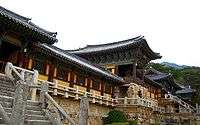 | ||||||||
| Prehistoric period | ||||||||
| Ancient period | ||||||||
|
||||||||
| Proto–Three Kingdoms period | ||||||||
| Three Kingdoms period | ||||||||
|
||||||||
| Northern and Southern States period | ||||||||
|
||||||||
| Later Three Kingdoms period | ||||||||
|
||||||||
| Dynastic period | ||||||||
|
||||||||
| Colonial period | ||||||||
|
||||||||
| Modern period | ||||||||
|
||||||||
| Topics | ||||||||
| Timeline | ||||||||
Early Joseon period
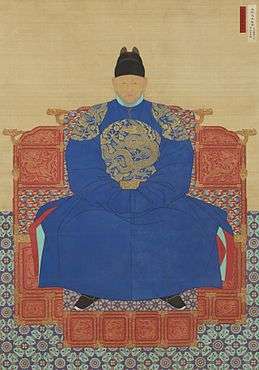
Founding
By the late 14th century, the nearly 500-year-old Goryeo established in 918 was tottering, its foundations collapsing from years of war and de facto occupation from the disintegrating Mongol Empire. Following the emergence of the Ming dynasty, the royal court in Goryeo split into two conflicting factions: the group led by General Yi (supporting the Ming) and the camp led by General Choe (standing by the Yuan).
Goryeo claimed to be the successor of the ancient kingdom of Goguryeo (which was later renamed Goryeo); as such, restoring Manchuria as part of Korean territory was part of its foreign policy throughout its history. When a Ming messenger came to Goryeo in 1388, the 14th year of U of Goryeo, to demand that Goguryeo's former northern territory be handed over to Ming China, General Choe seized the chance to argue for an attack on the Liaodong Peninsula.
Yi was chosen to lead the attack; however, he revolted and swept back to Gaegyeong and initiated a coup d'état, overthrowing King U in favor of his son, Chang of Goryeo (1388). He later killed King U and his son after a failed restoration and forcibly placed a royal named Yi on the throne (he became Gongyang of Goryeo). In 1392, Yi eliminated Jeong Mong-ju, highly respected leader of a group loyal to Goryeo dynasty, and dethroned King Gongyang, exiling him to Wonju, and before he ascended the throne. The Goryeo Dynasty had come to an end after almost 500 years of rule.
In the beginning of his reign, Yi Seonggye, now ruler of Korea, intended to continue use of the name Goryeo for the country he ruled and simply change the royal line of descent to his own, thus maintaining the façade of continuing the 500-year-old Goryeo tradition. However, after numerous threats of mutiny from the drastically weakened but still influential Gwonmun nobles, who continued to swear allegiance to the remnants of the Goryeo and now the demoted Wang clan, the consensus in the reformed court was that a new dynastic title was needed to signify the change. In naming the new dynasty, Taejo contemplated two possibilities - "Hwaryeong" and "Joseon". After much internal deliberation, as well as endorsement by the neighboring Ming dynasty's emperor, Taejo declared the name of the kingdom to be Joseon, a tribute to the ancient Korean state of Gojoseon.[12] He also moved the capital to Hanyang from Kaesong.
Strife of princes
.jpg)
When the new dynasty was brought into existence, Taejo brought up the issue of which son would be his successor. Although Yi Bangwon, Taejo's fifth son by Queen Sineui, had contributed most to assisting his father's rise to power, the prime minister Jeong Dojeon and Nam Eun used their influence on King Taejo to name his eighth son (second son of Queen Sindeok) Grand Prince Uian (Yi Bangseok) as crown prince in 1392. This conflict arose largely because Jeong Dojeon, who shaped and laid down ideological, institutional, and legal foundations of the new dynasty more than anyone else, saw Joseon as a kingdom led by ministers appointed by the king while Yi Bangwon wanted to establish the absolute monarchy ruled directly by the king. With Taejo's support, Jeong Dojeon kept limiting the royal family's power by prohibiting political involvement of princes and attempting to abolish their private armies. Both sides were well aware of each other's great animosity and were getting ready to strike first.
After the sudden death of Queen Sindeok, while King Taejo was still in mourning for his second wife, Yi Bangwon struck first by raiding the palace and killed Jeong Dojeon and his supporters as well as Queen Sindeok's two sons (his half-brothers) including the crown prince in 1398. This incident became known as the First Strife of Princes.
Aghast at the fact that his sons were willing to kill each other for the crown, and psychologically exhausted from the death of his second wife, King Taejo abdicated and immediately crowned his second son Yi Banggwa as King Jeongjong. One of King Jeongjong's first acts as monarch was to revert the capital to Kaesong, where he is believed to have been considerably more comfortable, away from the toxic power strife. Yet Yi Bangwon retained real power and was soon in conflict with his disgruntled older brother, Yi Banggan, who also yearned for power. In 1400, the tensions between Yi Bangwon's faction and Yi Banggan's camp escalated into an all-out conflict that came to be known as the Second Strife of Princes. In the aftermath of the struggle, the defeated Yi Banggan was exiled to Dosan while his supporters were executed. Thoroughly intimidated, King Jeongjong immediately invested Yi Bangwon as heir presumptive and voluntarily abdicated. That same year, Yi Bangwon assumed the throne of Joseon at long last as King Taejong, third king of Joseon.
Consolidation of royal power
In the beginning of Taejong's reign, the Grand King Former, Taejo, refused to relinquish the royal seal that signified the legitimacy of any king's rule. Taejong began to initiate policies he believed would prove his qualification to rule. One of his first acts as king was to abolish the privilege enjoyed by the upper echelons of government and the aristocracy to maintain private armies. His revoking of such rights to field independent forces effectively severed their ability to muster large-scale revolts, and drastically increased the number of men employed in the national military. Taejong's next act as king was to revise the existing legislation concerning the taxation of land ownership and the recording of state of subjects. With the discovery of previously hidden land, national income increased twofold.
In 1399, Taejong had played an influential role in scrapping the Dopyeong Assembly, a council of the old government administration that held a monopoly in court power during the waning years of the Goryeo Dynasty, in favor of the State Council of Joseon (Hangul: 의정부 hanja: 議政府), a new branch of central administration that revolved around the king and his edicts. After passing the subject documentation and taxation legislation, King Taejong issued a new decree in which all decisions passed by the State Council could only come into effect with the approval of the king. This ended the custom of court ministers and advisors making decisions through debate and negotiations amongst themselves, and thus brought the royal power to new heights.
Shortly thereafter, Taejong installed an office, known as the Sinmun Office, to hear cases in which aggrieved subjects felt that they had been exploited or treated unjustly by government officials or aristocrats. However, Taejong kept Jeong Dojeon's reforms intact for most part. In addition, Taejong executed or exiled many of his supporters who helped him ascend on the throne in order to strengthen the royal authority. To limit influence of in-laws, he also killed all four of his Queen's brothers and his son Sejong's father-in-law. Taejong remains a controversial figure who killed many of his rivals and relatives to gain power and yet ruled effectively to improve the populace's lives, strengthen national defense, and lay down a solid foundation for his successor Sejong's rule.
Sejong the Great


In August 1418, following Taejong's abdication two months earlier, Sejong the Great ascended the throne. In May 1419, King Sejong, under the advice and guidance of his father Taejong, embarked upon the Gihae Eastern Expedition to remove the nuisance of waegu (coastal pirates) who had been operating out of Tsushima Island.
In September 1419, the daimyō of Tsushima, Sadamori, capitulated to the Joseon court. In 1443, The Treaty of Gyehae was signed in which the daimyō of Tsushima was granted rights to conduct trade with Korea in fifty ships per year in exchange for sending tribute to Korea and aiding to stop any Waegu coastal pirate raids on Korean ports.[13][14][15][16]
On the northern border, Sejong established four forts and six posts (hanja: 四郡六鎭; Hangul: 사군육진) to safeguard his people from the Jurchens, who later became the Manchus, living in Manchuria. In 1433, Sejong sent Kim Jong-seo, a government official, north to fend off the Jurchens. Kim's military campaign captured several castles, pushed north, and restored Korean territory, roughly the present-day border between North Korea and China.[17]
During the rule of Sejong, Korea saw advances in natural science, agriculture, literature, traditional Chinese medicine, and engineering. Because of such success, Sejong was given the title "Sejong the Great".[18] The most remembered contribution of King Sejong is the creation of Hangul, the Korean alphabet, in 1443; everyday use of Hanja in writing eventually was surpassed by Hangul in the later half of the 20th century.
Six martyred ministers
After King Sejong's death, his son Munjong continued his father's legacy but soon died of illness in 1452, just two years after coronation. He was succeeded by his twelve-year-old son, Danjong. In addition to two regents, Princess Gyeonghye also served as Danjong's guardian and, along with the general Kim Jongso, attempted to strengthen royal authority.[19] However, Danjong's uncle, Sejo, gained control of the government and eventually deposed his nephew to become the seventh king of Joseon himself in 1455. After six ministers loyal to Danjong attempted to assassinate Sejo to return Danjong to the throne, Sejo executed the six ministers and also killed Danjong in his place of exile.
King Sejo enabled the government to determine exact population numbers and to mobilize troops effectively. He also revised the land ordinance to improve the national economy and encouraged publication of books. Most importantly, he compiled the Grand Code for State Administration, which became the cornerstone of dynastic administration and provided the first form of constitutional law in a written form in Korea.
However, he undermined much foundation of the many systems including the Jiphyeonjeon which his predecessors King Sejong and Munjong had carefully laid down, cutting down on everything he deemed unworthy of the effort and thus caused countless complications in the long run. Much of his own adjustments were done for his own power, not regarding the consequences and problems that would occur. Furthermore, the relentless favoritism which he showed towards the ministers who aided him in the taking of the throne led to much corruption in the higher echelon of the political field.
Institutional arrangements and Prosper culture
Sejo's weak son Yejong succeeded him as the eighth king, but died two years later in 1469. Yejong's nephew Seongjong ascended the throne. His reign was marked by the prosperity and growth of the national economy and the rise of neo-Confucian scholars called sarim who were encouraged by Seongjong to enter court politics. He established Hongmungwan (hanja: 弘文館), the royal library and advisory council composed of Confucian scholars, with whom he discussed philosophy and government policies. He ushered in a cultural golden age that rivaled Sejong's reign by publishing numerous books on geography, ethics, and various other fields.
He also sent several military campaigns against the Jurchens on the northern border in 1491, like many of his predecessors. The campaign, led by General Heo Jong, was successful, and the defeated Jurchens, led by the Udige clan (hanja: 兀狄哈), retreated to the north of the Yalu River. King Seongjong was succeeded by his son, Yeonsangun, in 1494.
Literati purges
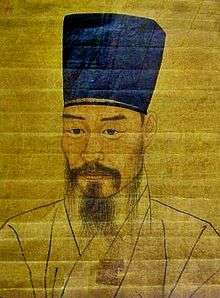
Yeonsangun is often considered the worst tyrant of the Joseon, whose reign was marked by Korean literati purges between 1498 and 1506. His behavior became erratic after he learned that his biological mother was not Queen Junghyeon but the deposed Queen Lady Yun, who was forced to drink poison after poisoning one of Seongjong's concubines out of jealousy and leaving a scratch mark on Seongjong's face. When he was shown a piece of clothing that was allegedly stained with his mother's blood vomited after drinking poison, he beat to death two of Seongjong's concubines who had accused Consort Yun and he pushed Grand Queen Insu, who died afterward. He executed government officials who supported Consort Yun's death along with their families. He also executed sarim scholars for writing phrases critical of Sejo's usurpation of the throne.
Yeonsangun also seized a thousand women from the provinces to serve as palace entertainers and appropriated the Sungkyunkwan as a personal pleasure ground. He abolished the Office of Censors, whose function was to criticize inappropriate actions and policies of the king, and Hongmungwan. He banned the use of hangul when the common people wrote with it on posters criticizing the king. After twelve years of misrule, he was finally deposed in a coup that placed his half-brother Jungjong on the throne in 1506.
Jungjong was a fundamentally weak king because of the circumstances that placed him on the throne, but his reign also saw a period of significant reforms led by his minister Jo Gwang-jo, the charismatic leader of sarim. He established a local self-government system called hyangyak to strengthen local autonomy and communal spirit among the people, sought to reduce the gap between the rich and poor with a land reform that would distribute land to farmers more equally and limit the amount of land and number of slaves that one could own, promulgated widely among the populace Confucian writings with vernacular translations, and sought to trim the size of government by reducing the number of bureaucrats. According to the Veritable Records of the Joseon Dynasty, it was said that no official dared to receive a bribe or exploit the populace during this time because as Inspector General, he applied law strictly.
These radical reforms were very popular with the populace but were fiercely opposed by the conservative officials who helped to put Jungjong on the throne. They plotted to cause Jungjong to doubt Jo's loyalty. Jo Gwangjo was executed, and most of his reform measures died with him in the resulting Third Literati Purge of 1519. For nearly 50 years afterward, the court politics was marred by bloody and chaotic struggles between factions backing rival consorts and princes. In-laws of the royal family wielded great power and contributed to much corruption in that era.
Middle Joseon period
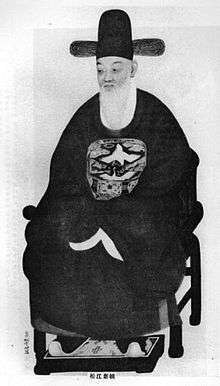
The middle period of Joseon dynasty was marked by a series of intense and bloody power struggles between political factions that weakened the country and large-scale invasions by Japan and Manchu that nearly toppled the dynasty.
Factional struggle
The Sarim faction had suffered a series of political defeats during the reigns of Yeonsangun, Jungjong, and Myeongjong, but it gained control of the government during the reign of King Seonjo. It soon split into opposing factions known as the Easterners and the Westerners. Within decades the Easterners themselves divided into the Southerners and the Northerners; in the seventeenth century the Westerners as well permanently split into the Noron and the Soron.[20] The alternations in power among these factions were often accompanied by charges of treason and bloody purges, initiating a cycle of revenge with each change of regime.
One example is the 1589 rebellion of Jeong Yeo-rip, one of the bloodiest political purges of Joseon. Jeong Yeo-rip, an Easterner, had formed a society with group of supporters that also received military training to fight against Waegu. There is still a dispute about the nature and purpose of his group, which reflected desire for classless society and spread throughout Honam. He was subsequently accused of conspiracy to start a rebellion. Jeong Cheol, head of the Western faction, was in charge of investigating the case and used this event to effect widespread purge of Easterners who had slightest connection with Jeong Yeo-rip. Eventually 1000 Easterners were killed or exiled in the aftermath.
Early Japanese invasions
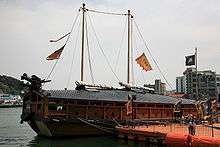
Throughout Korean history, there was frequent piracy on sea and brigandage on land. The only purpose for the Joseon navy was to secure the maritime trade against the wokou. The navy repelled pirates using an advanced form of gunpowder technologies including cannons and fire arrows in form of singijeon deployed by hwacha.
During the Japanese invasions in the 1590s, Toyotomi Hideyoshi, plotting the conquest of Ming China with Portuguese guns, invaded Korea with his daimyōs and their troops, intending to use Korea as a stepping stone. Factional division in the Joseon court, inability to assess Japanese military capability, and failed attempts at diplomacy led to poor preparation on Joseon's part. The use of European firearms by the Japanese left most of the southern part of the Korean Peninsula occupied within months, with both Hanseong (present-day Seoul) and Pyongyang captured.
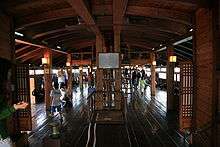
However, the invasion was slowed when Admiral Yi Sun-sin destroyed the Japanese invasion fleet. The guerrilla resistance that eventually formed also helped. Local resistance slowed down the Japanese advance and decisive naval victories by Admiral Yi left control over sea routes in Korean hands, severely hampering Japanese supply lines. Furthermore, Ming China intervened on the side of the Koreans, sending a large force in 1593 which pushed back the Japanese together with the Koreans.
During the war, Koreans developed powerful firearms and the turtle ships. The Joseon and Ming forces defeated the Japanese at a deep price. Following the war, relations between Korea and Japan were completely suspended until 1609.
Manchu invasions
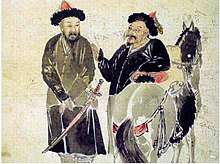
After the Japanese invasions, the Korean Peninsula was devastated. Meanwhile, Nurhaci (r. 1583–1626), the chieftain of the Jianzhou Jurchens, was unifying the Jurchen tribes of Manchuria into a strong coalition that his son Hong Taiji (r. 1626-–1643) would eventually rename the "Manchus." After he declared Seven Grievances against Ming China in 1618, Nurhaci and the Ming engaged in several military conflicts. On such occasions, Nurhaci required help from Gwanghaegun of Joseon (r.1608–1623), putting the Korean state in a difficult position because the Ming court was also requesting assistance.[21] Gwanghaegun tried to maintain neutrality, but most of his officials opposed him for not supporting Ming China, which had saved Joseon during Hideyoshi's invasions.[21]
In 1623, Gwanghaegun was deposed and replaced by Injo of Joseon (r. 1623–1649), who banished Gwanghaejun's supporters. Reverting his predecessor's foreign policy, the new king decided to openly support the Ming, but a rebellion led by military commander Yi Gwal erupted in 1624 and wrecked Joseon's military defenses in the north.[21] Even after the rebellion had been suppressed, King Injo had to devote military forces to ensure the stability of the capital, leaving fewer soldiers to defend the northern borders.[21]
In 1627, a Jurchen army of 30,000 led by Nurhaci's nephew Amin overran Joseon's defenses.[22] After a quick campaign that was assisted by northern yangban who had supported Gwanghaegun, the Jurchens imposed a treaty that forced Joseon to accept "brotherly relations" with the Jurchen kingdom.[23] Because Injo persisted in his anti-Manchu policies, Qing emperor Hong Taiji sent a punitive expedition of 120,000 men to Joseon in 1636.[24] Defeated, King Injo was forced to end his relations with the Ming and recognize the Qing as suzerain instead.[25] Injo's successor Hyojong of Joseon (r. 1649–1659) tried to form an army to keep his enemies away and conquer the Qing for revenge, but could never act on his designs.[26]
Despite reestablishing economic relations by officially entering the imperial Chinese tributary system, Joseon leaders and intellectuals remained resentful of the Manchus, whom they regarded as barbarians.[23] Long after submitting to the Qing, the Joseon court and many Korean intellectuals kept using Ming reign periods, as when a scholar marked 1861 as "the 234th year of Chongzhen."[27]
Late Joseon period
Emergence of Silhak and renaissance of the Joseon
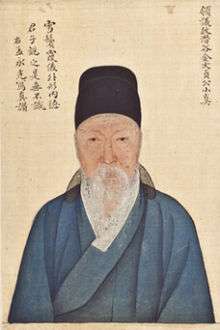
After invasions from Japan and Manchuria, Joseon experienced a nearly 200-year period of peace. Joseon witnessed the emergence of Silhak (Practical Learning). The early group of Silhak scholars advocated comprehensive reform of civil service examination, taxation, natural sciences and the improvement in agromanagerial and agricultural techniques. It aimed to rebuild Joseon society after it had been devastated by the two invasions. Under the leadership of Kim Yuk, the chief minister of King Hyeonjong, the implementation of reforms proved highly advantageous both to state revenues and to the lot of the peasants.
Factional conflict grew particularly intense under the reigns of the kings Sukjong and Gyeongjong, with major rapid reversals of the ruling faction, known as *hwanguk* (換局; literally change in the state of affairs), being commonplace. As a response, the next kings, Yeongjo and Jeongjo, generally pursued the Tangpyeongchaek - a policy of maintaining balance and equality between the factions.[28][29]
The two kings led a second renaissance of the Joseon dynasty.[30][31] Yeongjo's grandson, the enlightened King Jeongjo enacted various reforms throughout his reign, notably establishing Gyujanggak, a royal library in order to improve the cultural and political position of Joseon and to recruit gifted officers to run the nation. King Jeongjo also spearheaded bold social initiatives, opening government positions to those who would previously have been barred because of their social status. King Jeongjo had the support of the many Silhak scholars, who supported his regal power. King Jeongjo's reign also saw the further growth and development of Joseon's popular culture. At that time, the group of Silhak scholars encouraged the individual to reflect on state traditions and lifestyle, initiating the studies of Korea that addressed its history, geography, epigraphy and language.
Government by in-law families
After the death of King Jeongjo, the Joseon faced difficult external and internal problems. Internally, the foundation of national law and order weakened as a result of "Sedo" politics (in-law government) by royal in-law family.
Young King Sunjo succeeded King Jeongjo in 1800. With Jeongjo's death the Intransigent Patriarch faction seized power with the regency of Queen Dowager Jeongsun, whose family had strong ties to the Intransigents, and initiated a persecution of Catholics. But after the retirement and death of the Queen Dowager, the Intransigents were gradually ousted and the Expedient faction, including the Andong Kim family of Kim Jo-sun, the father of the queen, gained power. Gradually the Andong Kims came to dominate the court.[32]
With the domination of the Andong Kims, the era of *sedo politics* or in-law rule began. The formidable in-law lineage monopolized the vital positions in government, holding sway over the political scene, and intervening in the succession of the throne. These kings had no monarchic authority and could not rule over the government. The yangban of other families, overwhelmed by the power exercised by the royal in-laws, could not speak out. As the power was concentrated in the hands of the royal in-law lineage, there was disorder in the governing process and corruption became rampant. Large sums were offered in bribes to the powerful lineages to obtain positions with nominally high rank. Even the low-ranking posts were bought and sold. This period, which spanned 60 years, saw the manifestation of both severe poverty among the Korean population and ceaseless rebellions in various parts of the country.
Externally, Joseon became increasingly isolationist. Its rulers sought to limit contact with foreign countries.
End of the dynasty
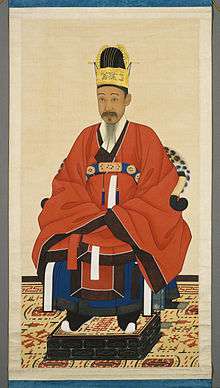
In 1863 King Gojong took the throne. His father, Regent Heungseon Daewongun, ruled for him until Gojong reached adulthood. During the mid-1860s the Regent was the main proponent of isolationism and the instrument of the persecution of native and foreign Catholics, a policy that led directly to the French Campaign against Korea in 1866. The early years of his rule also witnessed a large effort to restore the dilapidated Gyeongbok Palace, the seat of royal authority. During his reign, the power and authority of the in-law families such as the Andong Kims sharply declined. In order to get rid of the Andong Kim and Pungyang Cho families, he promoted persons without making references to political party or family affiliations, and in order to reduce the burdens of the people and solidify the basis of the nation's economy, he reformed the tax system. In 1871, U.S. and Korean forces clashed in a U.S. attempt at "gunboat diplomacy" following on the General Sherman incident of 1866.
In 1873, King Gojong announced his assumption of royal rule. With the subsequent retirement of Heungseon Daewongun, the future Queen Min (later called Empress Myeongseong) became a power in the court, placing her family in high court positions.
Japan, after the Meiji Restoration, acquired Western military technology, and forced Joseon to sign the Treaty of Ganghwa in 1876, opening three ports to trade and granting the Japanese extraterritoriality. Port Hamilton was occupied by the British Navy in 1885.
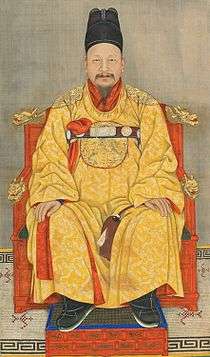
Many Koreans despised Japanese and foreign influences over their land and the corrupt oppressive rule of the Joseon Dynasty. In 1881, the Byeolgigun, a modern elite military unit, was formed with Japanese trainers. The salaries of the other soldiers were held back and in 1882 rioting soldiers attacked the Japanese officers and even forced the queen to take refuge in the countryside. In 1894, the Donghak Peasant Revolution saw farmers rise up in a mass rebellion, with peasant leader Jeon Bong-jun defeating the forces of local ruler Jo Byong-gap at the battle of Go-bu on January 11, 1894; after the battle, Jo's properties were handed out to the peasants. By May, the peasant army had reached Jeonju, and the Joseon government asked the Qing dynasty government for assistance in ending the revolt. The Qing sent 3,000 troops and the rebels negotiated a truce, but the Japanese considered the Qing presence a threat and sent in 8,000 troops of their own, seizing the Royal Palace in Seoul and installing a pro-Japanese government on 8 June 1894. This soon escalated into the First Sino-Japanese War (1894–1895) between Japan and Qing China, fought largely in Korea. [*The king made a deal with Japan partially out of isolationist views and conservative-misogynistic distrust of the queen's support for open trade policies towards the Western civilizations and China. He ended up preempting a specific disadvantageous, exclusive negotiation with Japan previous to the Queen's decision, which was later used as a political premise for Japan to wage military action. Scholars particularly during the Joseon era were touted for expressing allegiance to the king]
Empress Myeongseong (referred to as "Queen Min"[33]) had attempted to counter Japanese interference in Korea and was considering turning to the Russian Empire or to China for support. In 1895, Empress Myeongseong was assassinated by Japanese agents.[34][34] The Japanese minister to Korea, Lieutenant-General Viscount Miura, almost certainly orchestrated the plot against her. A group of Japanese agents[34] entered the Gyeongbokgung Royal Palace in Seoul, which was under Japanese control,[34] and Queen Min was killed and her body desecrated in the North wing of the palace.
The Qing acknowledged defeat in the Treaty of Shimonoseki (17 April 1895), which officially guaranteed Korea's independence from China.[35] It was a step toward Japan gaining regional hegemony in Korea. The Joseon court, pressured by encroachment from larger powers, felt the need to reinforce national integrity and declared the Korean Empire, along with the Gwangmu Reform in 1897. King Gojong assumed the title of Emperor in order to assert Korea's independence. In addition, other foreign powers were sought for military technology, especially Russia, to fend off the Japanese. Technically, 1897 marks the end of the Joseon period, as the official name of the empire was changed; however the Joseon Dynasty would still reign, albeit perturbed by Japan and Russia.
In a complicated series of maneuvers and counter-maneuvers, Japan pushed back the Russian fleet at the Battle of Port Arthur in 1905. With the conclusion of the 1904–1905 Russo-Japanese War with the Treaty of Portsmouth, the way was open for Japan to take control of Korea. After the signing of the Protectorate Treaty in 1905, Korea became a protectorate of Japan. Prince Itō was the first Resident-General of Korea, although he was assassinated by Korean independence activist An Jung-geun in 1909 at the train station at Harbin. In 1910 the Japanese Empire finally annexed Korea.
Government
Joseon dynasty was a highly centralized monarchy and neo-Confucian bureaucracy as codified by Gyeongguk daejeon, a sort of Joseon constitution.
King
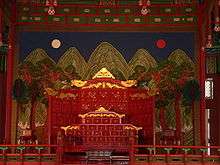
The king had absolute authority, but his actual power varied with political circumstances. He was bound by tradition, precedents set by earlier kings, Gyeongguk daejeon, and Confucian teachings. The king commanded absolute loyalty from his officials and subjects, but the officials were also expected to persuade the king to the right path if the latter was thought to be mistaken. The natural disasters were thought to be due to the king's failings, and therefore, Joseon kings were very sensitive to their occurrences. When there was severe drought or a series of disasters, the king often formally sought criticism from both the officials and citizenry, and whatever they said or wrote were protected from prosecution in such cases (although there were a few exceptions).
Direct communication between the king and the common people was possible through the sangeon (상언; 上言) written petition system and the gyeokjaeng (격쟁; 擊錚) oral petition system. Through the gyeokjaeng oral petition system, commoners could strike a gong or drum in front of the palace or during the king's public processions in order to appeal their grievances or petition to the king directly. This allowed even the illiterate members of Joseon society to make a petition to the king. More than 1,300 gyeokjaeng-related accounts are recorded in the Ilseongnok.[36][37][38]
Officials
The government officials were ranked in 18 levels, ranging from first senior rank (정1품, 正一品) down to ninth junior rank (종9품, 從九品) based on seniority and promotion, which was achieved through the royal decree based on examination or recommendation. The officials from 1st senior rank to 3rd senior rank wore red robes while those from 3rd junior rank to 6th junior rank wore blue and those below wore green robes.[39]
Here a government official refers to one who occupied a type of office that gave its holder a yangban status - semi-hereditary nobility that was effective for three generations. In order to become such an official, one had to pass a series of gwageo examinations. There were three kinds of gwageo exams - literary, military, and miscellaneous, among which literary route was the most prestigious. (Many of key posts including all Censorate posts were open only to officials who advanced through literary exam.) In case of literary route, there was a series of four tests, all of which one had to pass in order to qualify to become an official. 33 candidates who were chosen in this manner took the final exam before the king for placement. The candidate with the highest score was appointed to a position of 6th junior rank (a jump of six ranks). Two candidates with the next two highest scores were appointed to a position of 7th junior rank. Seven candidates with next highest scores were assigned to 8th junior rank while the remaining 23 candidates were given 9th junior rank, the lowest of 18 ranks.
The officials of 1st senior rank, 1st junior rank, and 2nd senior rank were addressed with honorific "dae-gam" (대감, 大監) while those of 2nd junior rank and 3rd senior rank were addressed with honorific "yeong-gam" (영감, 令監).[40] These red-robed officials, collectively called "dangsanggwan" (당상관, 堂上官), took part in deciding government policies by attending cabinet meetings. The rest of ranked officials were called "danghagwan" (당하관, 堂下官).
Central government
State Council
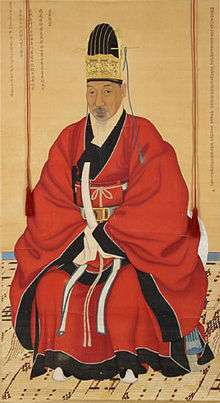
State Council (Uijeongbu, 의정부, 議政府) was the highest deliberative body, whose power however declined over the course of dynasty. The Chief State Councillor (Yeonguijeong, 영의정, 領議政), Left State Councillor (Jwauijeong, 좌의정, 左議政), and Right State Councillor (Uuijeong, 우의정, 右議政) were the highest-ranking officials in the government (All three were of 1st senior rank). They were assisted by Left Minister (Jwachanseong, 좌찬성, 左贊成) and Right Minister (Uichangseong, 우찬성, 右贊成), both of 1st junior rank, and seven lower ranking officials. The power of State Council was inversely proportional to the king's power. There were periods when it directly controlled Six Ministries, the chief executive body of Joseon government, but it primarily served in advisory role under stronger kings. State councillors served in several other positions concurrently.
Six Ministries
Six Ministries (Yukjo, 육조, 六曹) make up the chief executive body. Each minister (Panseo, 판서, 判書) was of 2nd senior rank and was assisted by deputy minister (Champan, 참판, 參判), who was of 2nd junior rank. Ministry of Personnel was the most senior office of six ministries. As the influence of State Council waned over time, Minister of Personnel was often de facto head of ministers. Six ministries include in the order of seniority.
- Ministry of Personnel (Ijo, 이조, 吏曹) - was primarily concerned with appointment of officials
- Ministry of Taxation (Hojo, 호조, 戶曹) - taxation, finances, census, agriculture, and land policies
- Ministry of Rites (Yejo, 예조, 禮曺) - rituals, culture, diplomacy, gwageo exam
- Ministry of Defence (Byeongjo, 병조, 兵曺) - military affairs
- Office of Police Bureau (Podocheong, 포도청, 捕盜廳) - office for public order
- Ministry of Justice (Hyeongjo, 형조, 刑曺) - administration of law, slavery, punishments
- Ministry of Commerce (Gongjo, 공조, 工曹) - industry, public works, manufacturing, mining
Three Offices
Three Offices, or Samsa (삼사), is a collective name for three offices that functioned as major organ of press and provided checks and balance on the king and the officials. While modeled after Chinese system, they played much more prominent roles in Joseon government than their Chinese counterparts. In their role as organ of press, they did not have actual authority to decide or implement policies, but had influential voice in the ensuing debate. The officials who served in these offices tended to be younger and of lower rank compared to other offices but had strong academic reputation and enjoyed special privileges and great prestige (For instance, censors were permitted to drink during working hours because of their function of criticizing the king). To be appointed, they went through more thorough review of character and family background. Three Offices provided the fastest route of promotion to high posts and was almost a requirement to becoming a State Councillor.
- Office of Inspector General (Saheonbu·사헌부) - It monitored government administration and officials at each level in both central and local governments for corruption, malfeasance, or inefficiency. It was also in charge of advancing public morals and Confucian customs and redressing grievances of the populace. It was headed by Inspector General (Daesaheon·대사헌), a position of 2nd junior rank, who oversaw 30 largely independent officials.
- Office of Censors (Saganwon·사간원) - Its chief function was to remonstrate with the king if there was wrong or improper action or policy. Important decrees of the king were first reviewed by censors, who could ask to withdraw them if judged improper. It also issued opinions about the general state of affairs. It was composed of five officials, led by Chief Censor (Daesagan·대사간), of 3rd senior rank.
While the primary focus for Office of Inspector General is the government officials and Office of Censors is focused on the king, two offices often performed each other's functions, and there was much overlap. Together they were called "Yangsa," (양사) which literally means "Both Offices," and often worked jointly especially when they sought to reverse the king's decision.
- Office of Special Advisors (Hongmungwan·홍문관 弘文館) - It oversaw the royal library and served as research institute to study Confucian philosophy and answer the king's questions. Its officials took part in the daily lessons called gyeongyeon (경연), in which they discussed history and Confucian philosophy with the king. Since these discussions often led to commentary on current political issues, its officials had significant influence as advisors. It was headed by Chief Scholar (Daejehak·대제학), a part-time post of 2nd senior rank that served concurrently in another high post (such as in State Council), and Deputy Chief Scholar (Bujehak·부제학), a full-time post of 3rd senior rank that actually ran the office. There was great prestige attached to being Chief Scholar in this deeply Confucian society. (The office was established to replace Hall of Worthies (Jiphyeonjeon·집현전) after the latter was abolished by King Sejo in the aftermath of Six martyred ministers.)
Other offices
The major offices include the following:
- Royal Secretariat (Seungjeongwon, 승정원) served as a liaison between the king and Six Ministries. There were six royal secretaries (승지), one for each ministry, and all were of 3rd senior rank. Their primary role was to pass down royal decree to the ministries and submit petitions from the officials and the populace to the king, but they also advised the king and served in other key positions close to the king. In particular Chief Royal Secretary (도승지), a liaison to Ministry of Personnel, served the king in the closest proximity of all government official and often enjoyed great power that was derived from the king's favor. Hong Guk-yeong (during Jeongjo's reign) and Han Myeong-hwe (during Sejo) are some examples of chief royal secretaries who were the most powerful official of their time.
- Capital Bureau (Hanseongbu, 한성부) was in charge of running the capital, Hanyang or present-day Seoul. It was led by Panyoon (판윤), of 2nd senior second rank equivalent to today's mayor of Seoul.
- Royal Investigation Bureau (Uigeumbu, 의금부) was an investigative and enforcement organ under direct control of the king. It chiefly dealt with treason and other serious cases that concerned the king and royal family and served to arrest, investigate, imprison, and carry out sentences against the suspected offenders, who were often government officials.[41]
- Office of Records (Chunchugwan, 춘추관) officials wrote, compiled, and maintained the government and historical records. It was headed by State Councillors, and many posts were held by officials serving in other offices concurrently. There were eight historiographers whose sole function was to record the meetings for history.[42]
- Seonggyungwan or Royal Academy (성균관) prepared future government officials. Those who passed first two stages of gwageo examinations (literary exam) were admitted to Seonggyungwan. The class size was usually 200 students, who lived in the residential hall and followed strict routine and school rules. (Tuition, room and board were provided by the government.) It also served as the state shrine for Confucian and Korean Confucian sages. The students' opinions on government policies, especially collective statements and demonstrations, could be influential as they represented fresh and uncorrupted consensus of young scholars. The official in charge was Daesaseong (대사성), of 3rd senior rank, and 36 other officials including those from other offices were involved in running the academy.
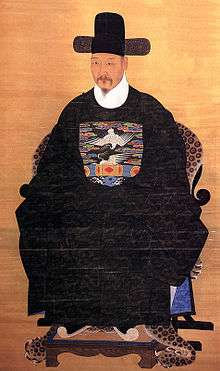
Local government
The officials of high rank were sent from the central government. Sometimes a secret royal inspector (Amhaeng-eosa·암행어사) was appointed by the king to travel incognito and monitor the provincial officials. These undercover inspectors were generally young officials of lower rank but were invested with the royal authority to dismiss corrupt officials.
- Provinces (Do·도 道) - There were eight provinces, each of which was governed by Governor (Gwanchalsa·관찰사 觀察使), a position of 2nd junior rank.
- Bu(부) - administrative offices in charge of major cities in provinces. Each bu was led by Buyoon (부윤), which was equivalent to Governor in rank.
- Mok (목 牧) - There were twenty moks, which governed large counties named 'ju'(주 州). They were run by Moksa (목사 牧使), of 3rd senior rank.
- County (Gun·군 郡) - There were eighty counties in Joseon, each governed by Gunsu (군수 郡守), a 4th junior rank.
- Hyeon (현 縣) - Large hyeons were governed by Hyeongryeong (현령 縣令) of 5th junior rank while smaller hyeons were governed by Hyeonggam (현감 縣監) of 6th junior rank.
Administrative divisions
During most of the Joseon Dynasty, Korea was divided into eight provinces (do; 도; 道). The eight provinces' boundaries remained unchanged for almost five centuries from 1413 to 1895, and formed a geographic paradigm that is still reflected today in the Korean Peninsula's administrative divisions, dialects, and regional distinctions. The names of all eight provinces are still preserved today, in one form or another.
Military
Royal Guards
Royal guards were elite troops consisting of 200 men tasked with guarding the king, queen, and ministers. These were soldiers hand selected by the king. They usually wore red robes
King's private guard
The King's private guard consisted of personal bodyguards of king. They wore black robes.
Central army
The central army consisted of 50000 troops. They usually wore green robes. They were commanded by generals appointed by the king.
Foreign affairs
China
Although the Joseon dynasty considered 1392 as the foundation of the Joseon kingdom, Imperial China did not immediately acknowledge the new government on the Korean peninsula. In 1401, the Ming court recognized Joseon as a tributary state in its tributary system. In 1403, the Yongle Emperor conveyed a patent and a gold seal to Taejong of Joseon, thus confirming his status and that of his dynasty.[43]
Traditionally, China had a laissez-faire policy toward Joseon; despite being a tributary of China, Joseon was autonomous in its internal and external affairs, and China did not manipulate or interfere in them. However, after 1879, China abandoned its laissez-faire policy and became directly involved in the affairs of Joseon. This "radical change in China's policy" was in reaction to the growing influence of Western powers and Japan in Joseon, and to ensure China's national security. China's new policy toward Joseon was set by Li Hongzhang and implemented by Yuan Shikai. According to Ming-te Lin: "Li's control of Korea from 1885 to 1894 through [Yuan Shikai] as resident official represented an anachronistic policy of intervention toward Korea."[44]
Gyorin
This long-term, strategic policy contrasts with the gyorin (kyorin) (neighborly relations) diplomacy in dealings with Jurchen, Japan, Ryukyu Kingdom, Siam and Java.[45] Gyorin was applied to a multi-national foreign policy.[46] The unique nature of these bilateral diplomatic exchanges evolved from a conceptual framework developed by the Chinese. Gradually, the theoretical models would be modified, mirroring the evolution of a unique relationship.[47]
Japan
As an initial step, a diplomatic mission was dispatched to Japan in 1402. The Joseon envoy sought to bring about the re-establishment of amicable relations between the two countries and he was charged to commemorate the good relations which existed in ancient times. This mission was successful, and shōgun Ashikaga Yoshimitsu was reported to have been favorably impressed by this initial embassy.[48] Not less than 70 diplomatic missions were dispatched from the Joseon capital to Japan before the beginning of Japan's Edo period.[49]
Reciprocal missions were construed as a means of communication between Korean kings and Japanese shōguns of almost equal ranking. The emperors of Japan at the time were figureheads with no actual political or military power[50][51] and the actual political and military rulers of Japan that Joseon communicated with were the shoguns who were represented as "tycoon of Japan" in many foreign communications in order to avoid the conflict with the Sinocentric system in which the emperor of China was the highest authority, and all rulers of tributary states were known as "kings".[52]
Society
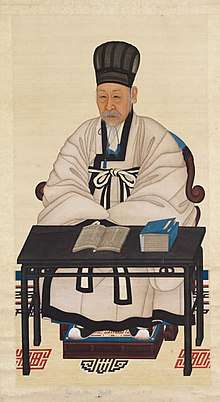
The exact population figures of Joseon-era Korea are disputed as government records of households are considered unreliable in this period.[53] Between 1810 and 1850, the population declined approximately 10% and remained stable.[54] Before the introduction of modern medicine by the Korean Empire government in the early 20th century, the average life expectancy for peasant and commoner Korean males was 24 and for females 26 years.[55]
Joseon Korea installed a centralised administrative system controlled by civil bureaucrats and military officers who were collectively called Yangban. By the end of the 18th century, the yangban had acquired most of the traits of a hereditary nobility except that the status was based on a unique mixture of family position, gwageo examinations for Confucian learning, and a civil service system. The family of a yangban who did not succeed to become a government official for the third generation lost their yangban status and became commoners. For most part, the only way to become a government official was to pass a series of gwageo exams (One had to pass "lesser gwageo" exam (소과) in both of two stages to qualify for greater gwageo exam, which again one had to pass in both of two stages to become a government official.) The yangban and the king, in an uneasy balance, controlled the central government and military institutions. The proportion of yangban may have reached as high as 30% by 1800, due to the later practices of transaction of yangban status to peasants, although there was considerable local variation.[56] As the government was small, a great many yangban were local gentry of high social status, but not always of high income.[57]
Another portion of the population were slaves or serfs (nobi), "low borns" (cheonmin) or untouchable outcastes (baekjeong). Slavery in Korea was hereditary, as well as a form of legal punishment. The nobi were socially indistinct from freemen other than the ruling yangban class, and some possessed property rights, legal entities and civil rights. Hence, some scholars argue that it's inappropriate to call them "slaves",[58] while some scholars describe them as serfs.[59][60] There were both government- and privately owned nobi, and the government occasionally gave them to yangban. Privately owned nobi could be inherited as personal property. During poor harvests, many sangmin people would voluntarily become nobi in order to survive. The nobi population could fluctuate up to about one-third of the population, but on average the nobi made up about 10% of the total population.[61] Joseon slaves could, and often did, own property.[62] Private slaves could buy their freedom.
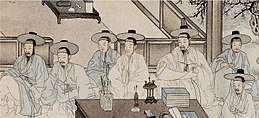
Many of the remaining 40-50% of the population were surely farmers,[63] but recent work has raised important issues about the size of other groups: merchants and traders, local government or quasi-governmental clerks (Chungin), craftsmen and laborers, textile workers, etc.[64] Given the size of the population, it may be that a typical person had more than one role. Most farming was, at any rate, commercial, not subsistence.[65] In addition to generating additional income, a certain amount of occupational dexterity may have been required to avoid the worst effects of an often heavy and corrupt tax system.[66]
During the Late Joseon, the Confucian ideals of propriety and "filial piety" gradually came to be equated with a strict observance to a complex social hierarchy, with many fine gradations. By the early 18th century the social critic Yi Junghwan (1690–1756) sarcastically complained that "[W]ith so many different ranks and grades separating people from one another, people tend not to have a very large circle of friends."[67] But, even as Yi wrote, the informal social distinctions of the Early Joseon were being reinforced by legal discrimination, such as Sumptuary law[68] regulating the dress of different social groups, and laws restricting inheritance and property ownership by women.[69]
Yet, these laws may have been announced precisely because social mobility was increasing, particularly during the prosperous century beginning about 1710.[70] The original social hierarchy of the Joseon Dynasty was developed based on the social hierarchy of the Goryeo era. In the 14th–16th centuries, this hierarchy was strict and stable. Since economic opportunities to change status were limited, no law was needed.
In the late 17–19th centuries, however, new commercial groups emerged, and the old class system was extremely weakened. Especially, the population of Daegu region's Yangban class was expected to reach nearly 70 percent in 1858.[71]
In 1801, Government-owned slaves were all emancipated, and the institution gradually died out over the next century.[72] By 1858 the nobi population stood at about 1.5 percent of the total population of Korea.[73] The institution was completely abolished as part of a social plan in the Gabo Reform of 1894.
Culture
The Joseon Dynasty presided over two periods of great cultural growth, during which Joseon culture created the first Korean tea ceremony, Korean gardens, and extensive historic works. The royal dynasty also built several fortresses and palaces.
Clothing
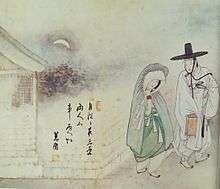
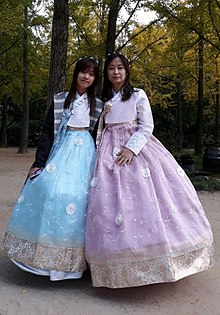
In Joseon Dynasty, jeogori of women's hanbok became gradually tightened and shortened. In the 16th century, jeogori was baggy and reached below the waist, but by the end of Joseon Dynasty in the 19th century, jeogori was shortened to the point that it did not cover the breasts, so another piece of cloth (heoritti) was used to cover them. At the end of the 19th century, Daewon-gun introduced Magoja, a Manchu-style jacket, to Korea, which is often worn with hanbok to this day.
Chima was full-skirted and jeogori was short and tight in the late Joseon period. Fullness in the skirt was emphasized round the hips. Many undergarments were worn underneath chima such as darisokgot, soksokgot, dansokgot, and gojengi to achieve a desired silhouette. Because jeogori was so short it became natural to expose heoritti or heorimari which functioned like a corset. The white linen cloth exposed under jeogori in the picture is heoritti.
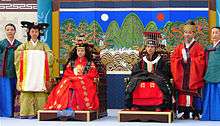
The upper classes wore hanbok of closely woven ramie cloth or other high-grade lightweight materials in warm weather and of plain and patterned silks the rest of the year. Commoners were restricted by law as well as resources to cotton at best. The upper classes wore a variety of colors, though bright colors were generally worn by children and girls and subdued colors by middle-aged men and women. Commoners were restricted by law to everyday clothes of white, but for special occasions they wore dull shades of pale pink, light green, gray, and charcoal. Formally, when Korean men went outdoors, they were required to wear overcoats known as durumagi which reach the knees.
Art
.gif)
The Mid-Joseon dynasty painting styles moved towards increased realism. A national painting style of landscapes called "true view" began - moving from the traditional Chinese style of idealized general landscapes to particular locations exactly rendered. While not photographic, the style was academic enough to become established and supported as a standardized style in Korean painting. At this time China ceased to have pre-eminent influence, Korean art took its own course, and became increasingly distinctive to the traditional Chinese painting.[74]

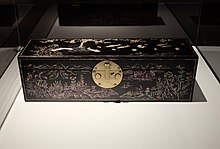
Ceramics are a form of popular art during the Joseon Dynasty. Examples of ceramics include white porcelain or white porcelain decorated with cobalt, copper red underglaze, blue underglaze and iron underglaze. Ceramics from the Joseon period differ from other periods because artists felt that each piece of art deserved its own uniquely cultivated personality.[75]
Beginning in the 10th century, white porcelain has been crafted in Korea. Historically overshadowed by the popularity of celadon, it was not until the 15th and 16th centuries that white porcelain was recognized for its own artistic value. Among the most prized of Korean ceramics are large white jars. Their shape is symbolic of the moon and their color is associated with the ideals of purity and modesty of Confucianism. During this period, the bureau that oversaw the meals and court banquets of the royal family strictly controlled the production of white porcelain.[75]
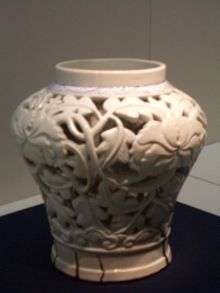
Blue and white porcelain artifacts decorating white porcelain with paintings and designs in underglaze by using natural cobalt pigment are another example of popular wares of the Joseon period. Many of these items were created by court painters employed by the royal family. During this period, the popular style of landscape paintings is mirrored in the decoration of ceramics.[75] Initially developed by the Chinese at the Jingdezhen kilns in the mid-14th century, Joseon began to produce this type of porcelain from the 15th century under Chinese influence. The first cobalt imported from China was used by Korean artists. In 1463 when sources of cobalt were discovered in Korea, artists and their buyers found the material was inferior in quality and preferred the more expensive imported cobalt. Korean porcelain with imported cobalt decoration contradict the emphasis of an orderly, frugal and moderate life in Neo-Confucianism.[75]
Strikingly different from cobalt, porcelain items with a copper-red underglaze are the most difficult to successfully craft. During production, these items require great skill and attention or will turn gray during the process of firing. While the birthplace of ceramics with copper red underglaze is widely disputed, these items originated during 12th century in Korea and became increasingly popular during the second half of the Joseon period. Some experts have pointed to the kilns of Bunwon-ri in Gwangju, Gyeonggi, a city that played a significant role in the production of ceramics during the Joseon period, as a possible birthplace.[75]
Porcelain was also decorated with iron. These items commonly consisted of jars or other utilitarian pieces.[75]
Literature
During the Joseon dynasty, the Yangban scholars and educated literati studied Confucian classics and Neo-Confucian literature.[2][3]:204
The middle and upper classes of Joseon society were proficient in Classical Chinese.[3]:329 The Joseon official records (such as the Veritable Records of the Joseon Dynasty and Seungjeongwon ilgi) and the written works of the Yangban literati were written in Classical Chinese.[2][3]:243,329[4]:74
Newspapers like the Hwangseong Sinmun towards the end of the dynasty were written in the Korean language using the Korean mixed script.[3]:329
Annals of the Joseon Dynasty
The Veritable Records of the Joseon Dynasty (also known as the Annals of the Joseon Dynasty) are the annual records of the Joseon Dynasty, which were kept from 1413 to 1865. The annals, or sillok, comprise 1,893 volumes and are thought to cover the longest continual period of a single dynasty in the world. With the exception of two sillok compiled during the colonial era, the Annals are the 151st national treasure of Korea and listed in UNESCO's Memory of the World registry.
Uigwe
Uigwe is a collection of royal protocols of the Joseon Dynasty, which records and prescribes through text and stylized illustration the important ceremonies and rites of the royal family.
Education
Buddhism and Confucianism
The Joseon dynasty was noted for having Confucianism as its main philosophy. However Buddhism actually was a part of the Joseon dynasty. The study of literary exchanges between Confucian scholar officials and Buddhists shows that Buddhism was not cast out. There literary exchanges show a middle ground of both philosophies. "scholar-officials - Some who in public castigated Buddhism as a heresy and deluded tradition, in private visited temples and associated closely with monks." This shows that while in public some scholars shamed Buddhism their exchanges with Buddhists show that in the very least it was not cast outside of their dynasty.
One example of this is a famous Joseon scholar official Pak Sedang (박세당, 朴世堂, 1629–1703). He argues against Buddhism with the following "People say that Han Yu and Ouyang Xiu have harshly criticized Buddhism and therefore have only discussed what is aberrant and have not fully investigated what is profound. People say, their understanding is lacking and they have not fully examined it [its profoundness]. I, myself, don’t think that is the case… The heresies under heaven, they are also rather foul. Among them, Buddhism is the worst. If a person is inclined to Buddhism then he is of the kind that pursues what is foul. Is it not clear that there is nothing further to discuss? It is like Mencius who [also felt no need to argue in detail when he] criticized Yang Zhu and Mozi.[76] Surely, he did not argue further than to say Yang Zhu and Mozi did not respect their fathers and their emperors."[76] However he writes a poem that seemingly supports Buddhism.
| 久離塵俗萬緣虛 | For long, I have left the mundane world whose innumerable conditions are empty; |
| 只愛游方不戀居 | I have but travelled here and there, finding no enjoyment in settled life. |
| 明日又浮滄海去 | Tomorrow once again I leave for Changhae; |
| 沃州寥落舊精廬 | The old, pure and simple hut of Okju province looks lonely. |
Buddhism was a part of the Joseon dynasty. While not supported publicly, privately it was very prevalent in Confucian-scholar officials.[77]
Music
The Joseon period developed several musical forms. The form with the most extant pieces is sijo[78] (Hangul: 시조/Hanja: 時調). Sijo is a poetic form consisting of three lines, each with four feet, traditionally sung very slowly. In Korean verse, a foot is generally a short syntactic unit, such as a noun with an adjective or a verb with an adverb. For example:
| 어인
WhyCOP.ATTR |
벌리완대
insect-ceaselessly |
낙락장송(落落長松)
tall and full pine tree |
다 먹는고
all eatQ |
| 부리 긴
beak longATTR |
져고리는
woodpeckerTOP |
어느 곳에
which placeLOC |
가 있는고
go existQ |
| 空山에
deserted mountainLOC |
落木聲 들릴제
sound of a tree falling audible FUT.ATTR |
내 안 들데
cause NEG actively AUX experienced |
업세라
not existEMP |
Translation
Can tiny insects devour a whole great spreading pine?
Where is the long-billed woodpecker? Why is he not here?
When I hear the sound of falling trees, I cannot contain myself for sorrow.[79]
Here, like other Korean musical forms, each foot can stand on its own. As sijo were sung in Korean, the pioneering of Hangul created the possibility for sijo to be written down without the use of substitutions such as Idu script. The first copy of sijo is of the 'Twelve Songs of Dosan' by Yi Hwang written in 1565, which were written 100 years after the proclamation of Hangul.[80] Additionally, the first anthology of sijo was compiled by Kim Cheontaek in 1728[81]; before the anthology few sijo were written.
Kim Cheontaek's anthology represents a change in the authorship of sijo. At first, sijo were primarily composed by the yangban aristocracy and entertainers of the Kisaeng class. However, by the mid-seventeenth century, the jungin or “professional class” were composing sijo as well. This also coincided with a new form of sijo called “narrative sijo” (Hangul: 사설시조/Hanja: 辭說時調), in which the first two lines were greatly lengthened. [82]This expansion is likely a development from the so-called “irregular sijo” (Hangul: 엇시조/Hanja: 旕時調), in which there was a minor lengthening of one of the first two lines.[83] While there are very few remaining irregular sijo, and the form has not been revived, there is a sizable body of narrative sijo and the form continues to evolve.
P'ansori (Hangul: 판소리) is another musical form that combines singing and prose to portray a story. Its development likely originates from shaman rituals and the songs within the Jeolla Province. It became a full-fledged musical form by the middle of the eighteenth century, and not long thereafter the yangban aristocracy also became interested in it. Originally there was a set of twelve stories that were sung, but only five were written down, and hence those five are the only ones sung today. Having been developed by commoners, p'ansori usually reflected their attitudes and aspirations, but by becoming popular with the yangban, p'ansori shifted somewhat toward yangban sensibilities and restrictions. P'ansori had a strong influence of the writing of the time, both because of the p'ansori novel (each based on one of the twelve stories) and by increasing the realism of the classical novel.
Science and technology

15th century
The Joseon Dynasty under the reign of Sejong the Great was Korea's greatest period of scientific advancement. Under Sejong's new policy, Cheonmin (low-status) people such as Jang Yeong-sil were allowed to work for the government. At a young age, Jang displayed talent as an inventor and engineer, creating machines to facilitate agricultural work. These included supervising the building of aqueducts and canals. Jang eventually was allowed to live at the royal palace, where he led a group of scientists to work on advancing Korea's science.
Some of his inventions were an automated (self-striking) water clock (the Jagyeokru) which worked by activating motions of wooden figures to indicate time visually (invented in 1434 by Jang), a subsequent more complicated water-clock with additional astronomical devices, and an improved model of the previous metal movable printing type created in the Goryeo Dynasty. The new model was of even higher quality and was twice as fast. Other inventions were the sight glass, and the udometer.
The highpoint of Korean astronomy was during the Joseon period, where men such as Jang created devices such as celestial globes which indicated the positions of the sun, moon, and the stars.[84] Later celestial globes (Gyupyo, 규표) were attuned to the seasonal variations.
The apex of astronomical and calendarial advances under King Sejong was the Chiljeongsan, which compiled computations of the courses of the seven heavenly objects (five visible planets, the sun, and moon), developed in 1442. This work made it possible for scientists to calculate and accurately predict all the major heavenly phenomena, such as solar eclipses and other stellar movements.[85] Honcheonsigye is an astronomical clock created by Song I-yeong in 1669. The clock has an armillary sphere with a diameter of 40 cm. The sphere is activated by a working clock mechanism, showing the position of celestial objects at any given time.
Kangnido, a Korean-made map of the world was created in 1402 by Kim Sa-hyeong (김사형, 金士衡), Yi Mu (이무, 李茂) and Yi Hoe (이회, 李撓). The map was created in the second year of the reign of Taejong of Joseon. The map was made by combining Chinese, Korean and Japanese maps.
16th–19th century
The scientific and technological advance in the late Joseon Dynasty was less progressed than the early Joseon period.
16th-century court physician, Heo Jun wrote a number of medical texts, his most significant achievement being Dongeui Bogam, which is often noted as the defining text of Traditional Korean medicine. The work spread to China and Japan, where it is still regarded as one of the classics of Oriental medicine today.
The first soft ballistic vest, Myunjebaegab, was invented in Joseon Korea in the 1860s shortly after the French campaign against Korea (1866). Heungseon Daewongun ordered development of bullet-proof armor because of increasing threats from Western armies. Kim Gi-du and Gang Yun found that cotton could protect against bullets if thick enough, and devised bullet-proof vests made of 30 layers of cotton. The vests were used in battle during the United States expedition to Korea (1871), when the US Navy attacked Ganghwa Island in 1871. The US Army captured one of the vests and took it to the US, where it was stored at the Smithsonian Museum until 2007. The vest has since been sent back to Korea and is currently on display to the public.
Economy
Commerce
During the Goryeo Dynasty, Korea had a healthy trade relationship with the Japanese, Chinese, and Manchurians. An example of prosperous, international trade port is Pyongnam. Koreans offered brocades, jewelries, ginseng, silk, and porcelain, renowned famous worldwide. But, during the Joseon Dynasty, Confucianism was adopted as the national philosophy, and, in process of eliminating certain Buddhist beliefs, Goryeo Cheongja porcelains were replaced by white Baekja, which lost favour of the Chinese. Also, commerce became more restricted during this time in order to promote agriculture. Because silver was used as currency in China, it played an important role in Korea-China trade.
Titles and styles during Joseon Kingdom
Titles and styles used inside the royal family were stratified along the generations and relative to the current King.
House of Yi
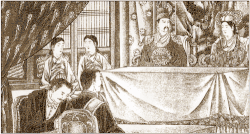
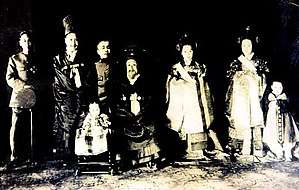
The following is a simplified relation of Joseon royalty (Korean Imperial Family) during the late period of the dynasty:
- Emperor Gojong (1852–1919) – 26th head of the Korean Imperial Household, adoptive heir to Crown Prince Hyomyeong
- Emperor Sunjong (1874–1926) – 27th head of the Korean Imperial Household
- Yi Kang, Prince Imperial Ui (1877–1955) – 5th son of Gojong
- Prince Yi Geon (1909–1991) – eldest son of Yi Kang; renounced the Imperial title and heritage by becoming a Japanese citizen in 1947
- Prince Yi U (1912–1945) – 2nd son of Yi Kang; adopted as the heir to Yi Jun-yong, grandson of Heungseon Daewongun
- Yi Cheong (1936–)
- Yi Jong (1940–1966)
- Yi Hae-won (1919–2020) – 2nd daughter of Yi Kang; married in 1936 to Yi Seung-gyu from the Yongin Yi Clan
- Yi Gap (1938–2014) – 9th son of Yi Kang
- Yi Won (1962–) – eldest son of Yi Gap; adopted by Yi Ku as the 30th head of the Korean Imperial Household
- 1st son (1998–)
- 2nd son (1999–)
- Yi Won (1962–) – eldest son of Yi Gap; adopted by Yi Ku as the 30th head of the Korean Imperial Household
- Yi Seok (1941–) – 10th son of Yi Kang; self-claimed head of the Korean Imperial Household
- Yi Hong (1976–), first daughter of Yi Seok
- 1st daughter (2001–)
- Yi Jin (1979–), 2nd daughter of Yi Seok
- Yi Jeonghun (1980–), son of Yi Seok
- Yi Hong (1976–), first daughter of Yi Seok
- Yi Un, Imperial Crown Prince (1897–1970) – 28th head of the Korean Imperial Household; married in 1920 to Princess Masako of Nashimoto (Yi Bangja), an imperial member of the Empire of Japan.
- Prince Yi Jin (1921–1922)
- Prince Yi Ku (1931–2005) — 29th head of the Korean Imperial Household; son of Yi Un
- Princess Deokhye (1912–1989) — married in 1931 to Count Sō Takeyuki
- Jong Jeonghye (1932–?), disappeared since 1956
See also
- History of Korea
- Annals of the Joseon Dynasty
- List of monarchs of Korea
- Kings family tree
- Joseon Dynasty politics
- Korean Empire
Notes
- Now Seoul, South Korea.
- Style: Yeonguijeong (1401-1894); Naegak chongri daesin (1894-96); Ui jeong (1896-1905)
References
- Li, Jun-gyu (이준규) (2009-07-22). (세상사는 이야기) 왜색에 물든 우리말-(10) (in Korean). Newstown.
1392년부터 1910년까지 한반도전역을 통치하였던 조선(朝鮮)은 일반적으로 조선왕조(朝鮮王朝)라 칭하였으며, 어보(御寶), 국서(國書)등에도 대조선국(大朝鮮國)이라는 명칭을 사용하였었다. (translation) Joseon which had ruled from 1392 to 1910 was commonly referred to as the "Joseon dynasty" while "Great Joseon State" was used in the royal seal, national documents, and others.
- Lee, Soyoung (October 2004). "Yangban: The Cultural Life of the Joseon Literati". Metropolitan Museum of Art. Retrieved 15 June 2020.
- Lee, Ki-baik (1984). A New History of Korea. Translated by Wagner, Edward Willett; Schultz, Edward J. Harvard University Press.
- {{cite book |title=New Insights From Recent Studies in Historical Astronomy: Following in the Footsteps of F. Richard Stephenson |first1=Wayne |last1=Orchiston |first2=David A. |last2=Green |first3=Richard |last3=Strom |publisher=Springer |year=2014]]
- Choi, Sang-hun (27 October 2017). "Interior Space and Furniture of Joseon Upper-class Houses". Ewha Womans University Press. p. 16 – via Google Books.
Joseon was an absolute monarchy
- 권태환 신용하 (1977). 조선왕조시대 인구추정에 관한 일시론.
- 이헌창 (1999). 한국경제통사 52쪽.
- "조선력사 시대구분표". Naenara (in Korean). Archived from the original on 2019-07-01. Retrieved 1 July 2019.
- "Korean History in Chronological Order". Naenara. Archived from the original on 2019-07-01. Retrieved 1 July 2019.
- "Chosŏn dynasty | Korean history". Encyclopedia Britannica. Encyclopædia Britannica, Inc. Retrieved 10 February 2019.
- "조선". 한국민족문화대백과.
- Kang, Jae-eun (2006). The Land of Scholars: Two Thousand Years of Korean Confucianism. Homa & Sekey Books. p. 177. ISBN 9781931907309. Retrieved August 7, 2015. "Yi Seong-gye issued a royal edict to proclaim the name of the new dynasty to "Joseon" and issued amnesty to all criminals who opposed the transition in dynasty. The statement by Taizu about "only the name of Joseon is beautiful and old" naturally refers to Gija Joseon."
- Richard Rutt.; et al. (September 1999). Korea. Routledge/Curzon. ISBN 978-0-7007-0464-4.
- John W. Hall.; et al. (April 27, 1990). The Cambridge history of Japan [Medieval Japan]. 3. Cambridge University Press. ISBN 978-0-521-22354-6.
- (in Korean) 계해약조 癸亥約條 Archived 2011-06-10 at the Wayback Machine Nate / Britannica
- (in Korean)계해조약 癸亥約條 Archived 2011-06-10 at the Wayback Machine Nate / Encyclopedia of Korean Culture
- 박영규 (2008). 한권으로 읽는 세종대왕실록. 웅진, 지식하우스. ISBN 978-89-01-07754-3.
- "King Sejong the Great And The Golden Age Of Korea". asiasociety.org. 19 August 2008. Retrieved 27 November 2009.
- An, Seung-jun (4 April 2014). "Forgotten story of Princess Gyeonghye". Korea Times. Retrieved 22 February 2018.
- Ebrey, Patricia; Walthall, Ann (2013). East Asia: A Cultural, Social, and Political History, Volume II: From 1600. Cengage Learning. p. 255. ISBN 978-1133606499. Retrieved July 15, 2015.
- Ebrey, Walthall & Palais 2006, p. 349.
- Kennedy 1943 (leader of the expedition); Ebrey, Walthall & Palais 2006, p. 350 (number of troops).
- Larsen 2008, p. 36.
- Ebrey, Walthall & Palais 2006, p. 350.
- Lee & de Bary 1997, p. 269.
- Larsen 2008, p. 36; Ebrey, Walthall & Palais 2006, p. 350.
- Kim Haboush 2005, p. 132.
- "탕평책". 한국민족문화대백과.
- 이성무 (November 12, 2007). 조선당쟁사 2 탕평과 세도정치: 숙종조~고종조. 아름다운날. ISBN 9788989354833.
- A Brief History of Korea. Ewha Womans University Press. ISBN 9788973006199. Retrieved 23 December 2016.
- Beirne, Paul. Su-un and His World of Symbols: The Founder of Korea's First Indigenous Religion. Routledge. ISBN 9781317047490. Retrieved 23 December 2016.
- 오영교 (July 25, 2007). 세도정권기 조선사회와 대전회통. 혜안. ISBN 9788984943131.
- Characteristics of Queen of Corea The New York Times November 10, 1895
- Park Jong-hyo (박종효), former professor at Lomonosov Moscow State University (2002-01-01). 일본인 폭도가 가슴을 세 번 짓밟고 일본도로 난자했다. Dong-a Ilbo (in Korean) (508). pp. 472 ~ 485.
- Joseon at the Encyclopædia Britannica
- "Ilseongnok: Records of Daily Reflections" (PDF). Memory of the World Register. UNESCO. Retrieved 6 December 2017.
- Injae, Lee; Miller, Owen; Jinhoon, Park; Hyun-Hae, Yi (2014). Korean History in Maps. Cambridge University Press. p. 93. ISBN 9781107098466. Retrieved 6 December 2017.
- "상언격쟁". 문화콘텐츠닷컴. Korea Creative Content Agency. Retrieved 6 December 2017.
- Gyeongguk daejeon
- Kyujanggak Institute for Korean Studies, "About Rank of Joseon Officials"
- 한성부 (in Korean). Doosan Encyclopedia. Retrieved 2014-03-01.
- 춘추관 (in Korean). Doosan Encyclopedia. Retrieved 2014-03-01.
- Kang, Etsuko H. (1997). Diplomacy and Ideology in Japanese-Korean Relations: from the Fifteenth to the Eighteenth Century, p. 49.
- Lin 2014, pp. 69–71.
- Chun-gil Kim The History of Korea, pp. 76-77. 7
- (in Korean) 사대교린 (조선 외교), Britannica online Korea
- Toby, Ronald P. (1991). State and Diplomacy in Early Modern Japan: Asia in the Development of the Tokugawa Bakufu, p. 87.
- Titsingh, p. 320.
- Lewis, James Bryant. Frontier contact between chosŏn Korea and Tokugawa Japan, p. 269 n. 89, citing Hanguk Chungse tae-il kysōpsa yŏngu (1996) by Na Chongpu.
- Shillony, Ben-Ami (2008). The Emperors of Modern Japan. ISBN 978-9004168220.
- Shillony, Ben-Ami (January 24, 2012). Jews & the Japanese: The Successful Outsiders. ISBN 9781462903962.
- Kang, Diplomacy and Ideology, p. 206.
- Ch'oe YH, PH Lee & WT de Bary (eds.) (2000), Sources of Korean Tradition: Volume II: From the Sixteenth to the Twentieth Centuries. Columbia University Press, p. 6
- Jun SH, JB Lewis & H-R Kang (2008), Korean Expansion and Decline from the Seventeenth to the Nineteenth Century: A View Suggested by Adam Smith. J. Econ. Hist. 68: 244–82.
- "...before the introduction of modern medicine in the early 1900s the average life expectancy for Koreans was just 24 for males and 26 for females." Lankov, Andrei; Kim EunHaeng (2007). The Dawn of Modern Korea. Seoul, South Korea: EunHaeng Namu. p. 47. ISBN 978-89-5660-214-1.
- Oh SC (2006), Economic growth in P'yongan Province and the development of Pyongyang in the Late Choson Period. Korean Stud. 30: 3–22
- Haboush JHK (1988), A Heritage of Kings: One Man's Monarchy in the Confucian World. Columbia University Press, pp. 88–9.
- Rhee, Young-hoon; Yang, Donghyu. "Korean Nobi in American Mirror: Yi Dynasty Coerced Labor in Comparison to the Slavery in the Antebellum Southern United States". Working Paper Series. Institute of Economic Research, Seoul National University.
- Bok Rae Kim (23 November 2004). "Nobi: A Korean System of Slavery". In Gwyn Campbell (ed.). Structure of Slavery in Indian Ocean Africa and Asia. Routledge. pp. 153–157. ISBN 978-1-135-75917-9.
- Palais, James B. (1998). Views on Korean social history. Institute for Modern Korean Studies, Yonsei University. p. 50. ISBN 9788971414415. Retrieved 15 February 2017.
Another target of his critique is the insistence that slaves (nobi) in Korea, especially in Choson dynasty, were closer to serfs (nongno) than true slaves (noye) in Europe and America, enjoying more freedom and independence than what a slave would normally be allowed.
- Rodriguez, Junius P. (1997). The Historical Encyclopedia of World Slavery. ABC-CLIO. p. 392. ISBN 9780874368857. Retrieved 14 February 2017.
10 percent of the total population on average, but it could rise up to one-third of the total.
- Haboush (1988: 88); Ch'oe et al. (2000: 158)
- Haboush, 1988: 89
- Jun SH & JB Lewis (2004), On double-entry bookkeeping in Eighteenth-century Korea: A consideration of the account books from two clan associations and a private academy. International Institute of Social History, Amsterdam, Netherlands (080626)
- Jun et al. (2008).
- Ch'oe et al. (2000: 73).
- 이중환, "총론" in 택리지, p. 355, quoted in translation in Choe et al. (2000: 162).
- Haboush (1988: 78)
- Haboush JHK (2003), Versions and subversions: Patriarchy and polygamy in Korean narratives, in D Ko, JHK Haboush & JR Piggott (eds.), Women and Confucian Cultures in Premodern China, Korea and Japan. University of California Press, pp. 279-304.
- Haboush (1988: 88-89); Oh (2006)
- 아틀라스 한국사 편찬위원회 (2004). 아틀라스한국사. 사계절. pp. 132–133. ISBN 978-89-5828-032-3.
- Ch'oe et al., 2000:7.
- Campbell, Gwyn (2004-11-23). Structure of Slavery in Indian Ocean Africa and Asia. Routledge. p. 163. ISBN 9781135759179. Retrieved 14 February 2017.
- "조선예술(朝鮮藝術) - 한국민족문화대백과사전". www.minbaek.kr. Retrieved 2020-02-03.
- Birmingham Museum of Art (2010). Birmingham Museum of Art : guide to the collection. [Birmingham, Ala]: Birmingham Museum of Art. pp. 35–39. ISBN 978-1-904832-77-5.
- Kim, Sung-Eun Thomas (20 August 2015). "A Shared Cultural Realm: Literary Exchanges between Scholar-Officials and Poet-Monks in the Mid Joseon Period". Seoul Journal of Korean Studies. 28 (1): 59–82. doi:10.1353/seo.2015.0015 – via Project MUSE.
- Kyuhee, Cho (2015). "Pathways to Korean Culture: Paintings of the Joseon Period (1392–1910) by Burglind Jungmann (review)". Seoul Journal of Korean Studies. Retrieved April 30, 2016.
- Kim, Hyŭnggyu. Understanding Korean Literature. p. 66.
- Rutt, Richard. The Bamboo Grove: An Introduction to Sijo. pp. No.15.
- Rutt, Richard. The Bamboo Grove: An Introduction to Sijo. p. 157.
- Rutt, Richard. The Bamboo Grove: An Introduction to Sijo. p. 158.
- Kim, Hyŭnggyu. Understanding Korean Literature. p. 71.
- "Naver".
- 백석기 (1987). 웅진위인전기 #11 장영실. 웅진출판사. p. 56.
- "Korea And The Korean People".
Bibliography
- Ebrey, Patricia Buckley; Walthall, Ann; Palais, James B. (2006), East Asia: A Cultural, Social, and Political History, Boston and New York: Houghton Mifflin Press, ISBN 978-0-618-13384-0.
- Hatada, Takashi; Smith Jr, Warren W.; Hazard, Benjamin H. (1969), A History of Korea, Santa Barbara, CA: ABC-Clio, ISBN 978-0-87436-064-6.
- Kennedy, George A. (1943), "Amin", in Arthur W. Hummel (ed.), Eminent Chinese of the Ch'ing Period (1644-1912), Washington: United States Government Printing Office, pp. 8–9.
- Kim Haboush, JaHyun (2005), "Contesting Chinese Time, Nationalizing Temporal Space: Temporal Inscription in Late Chosǒn Korea", in Lynn A. Struve (ed.), Time, Temporality, and Imperial Transition, Honolulu: University of Hawai'i Press, pp. 115–141, ISBN 978-0-8248-2827-1.
- Larsen, Kirk W. (2008), Tradition, Treaties, and Trade: Qing Imperialism and Chosǒn Korea, 1850–1910, Cambridge, MA: Harvard University Asia Center, ISBN 978-0-674-02807-4.
- Lee, Peter H.; de Bary, William Theodore (1997), Sources of Korean Tradition, Volume I: From Early Times Through the Sixteenth Century, New York: Columbia University Press, ISBN 978-0-231-10567-5.
- Lin, Ming-te (8 December 2014), "Li Hung-chang's Suzerain Policy toward Korea, 1882-1894", Chinese Studies in History, 24 (4): 69–96, doi:10.2753/CSH0009-4633240469
- Nahm, Andrew C. (1988), Korea: Tradition & Transformation: A History of the Korean People, Elizabeth, NJ: Hollym, ISBN 978-0-930878-56-6.
- Zhao, Quansheng (2003), "China and the Korean peace process", in Tae-Hwan Kwak; Seung-Ho Joo (eds.), The Korean Peace Process and the Four Powers, Hampshire: Ashgate, pp. 98–118, ISBN 978-0-7546-3653-3.
Further reading
- A Cultural History of Modern Korea, Wannae Joe, ed. with intro. by Hongkyu A. Choe, Elizabeth NY, and Seoul Korea: Hollym, 2000.
- An Introduction to Korean Culture, ed. Koo & Nahm, Elizabeth NJ, and Seoul Korea: Hollym, 1998. 2nd edition.
- Noon Eu Ro Bo Neun Han Gook Yuk Sa #7 by Jang Pyung Soon. Copyright 1998 Joong Ang Gyo Yook Yun Goo Won, Ltd, pp. 46–7.
- Alston, Dane. 2008. "Emperor and Emissary: The Hongwu Emperor, Kwŏn Kŭn, and the Poetry of Late Fourteenth Century Diplomacy". Korean Studies 32. University of Hawai'i Press: 104–47.
- Kye, Seung B.. 2010. "Huddling Under the Imperial Umbrella: A Korean Approach to Ming China in the Early 1500s". The Journal of Korean Studies 15 (1). University of Washington Center for Korea Studies: 41–66.
- Robinson, David M.. 2004. "Disturbing Images: Rebellion, Usurpation, and Rulership in Early Sixteenth-century East Asia—Korean Writings on Emperor Wuzong". The Journal of Korean Studies 9 (1). University of Washington Center for Korea Studies: 97–127.
- Robinson, Kenneth R.. 1992. "From Raiders to Traders: Border Security and Border Control in Early Chosŏn, 1392—1450". Korean Studies 16. University of Hawai'i Press: 94–115.
External links
| Wikimedia Commons has media related to Joseon Dynasty. |
- Cultural Values of the Choson Dynasty – from Instrok.org, created by the East Rock Institute.
- "Click into the Hermit Kingdom" (Written by Yang Sung-jin and published by Dongbang Media in Seoul, South Korea) – 100 articles in English on the Joseon Dynasty
- Korean royal family website – currently available only in Korean.
- Choson dynasty
- "Japanese Document Sheds New Light on Korean Queen's Murder" – Ohmynews.com's uncovered document about murder of Queen Minbi
- "E-Annals Bring Chosun History to Everyman", The Chosun Ilbo, January 27, 2006.
- "Korean Lee (Yi) Dynasty Granite Sculptures.
.png)
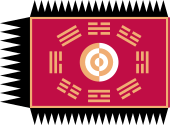
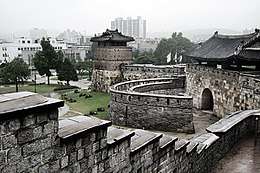
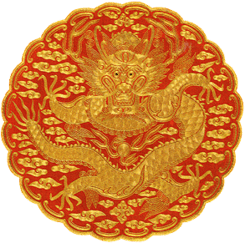
.jpg)